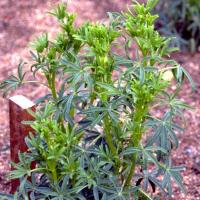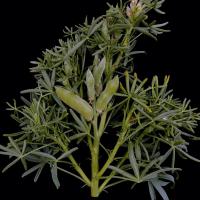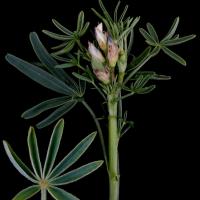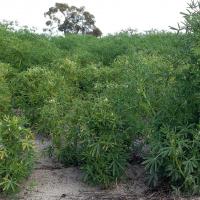Diagnosing bean yellow mosaic virus - non necrotic in narrow-leafed lupins
Bean yellow mosaic virus-non necrotic (BYMV-NN) is a rare symptom of the aphid-borne bean yellow mosaic virus that causes stunting without killing the plant before pod set. BYMV is found predominantly in high rainfall wheatbelt zones.
What to look for
- Stunted pale plants with deformed, often fleshy leaves.
- Plants are often affected first and most severely on paddock edges or other bare areas, particularly on the windward side and adjacent to legume pastures.
- Patches are also common with infection spreading out from the centre.
Paddock
- Stunted plants with shortened stems and petioles that give a bunchy appearance, and paler, mottled and deformed leaves.
- Older growth may be normal with bunching on new growth following aphid infection.
- Infected plants produce few seeds.
Plant
What else could it be
| Condition | Similarities | Differences |
|---|---|---|
| Diagnosing poor quality seed in narrow-leafed lupins | Reduced and staggered germination. Malformed seedlings | Allelopathy affected plants remain pale, distorted and stunted |
| Diagnosing seedbed constraints in narrow-leafed lupins and field peas | Reduced and staggered germination | The problem is more likely to vary between rows, and with changes in soil or landscape position. Established plants grow normally. |
| Diagnosing water repellence | Reduced and staggered germination | The problem is more likely to vary between rows, and with changes in soil type. |
| Diagnosing waterlogging in narrow-leafed lupins and field peas | Reduced and staggered germination | Waterlogged and saline areas are often clearly defined, and the problem is ongoing. |
| Diagnosing salinity in narrow-leafed lupins | Reduced and staggered germination | Waterlogged and saline areas are often clearly defined, and the problem is ongoing. |
Where did it come from?
- BYMV strains that are endemic in south-western Australia are not seed-borne in lupins, unlike overseas strains.
- The main source of BYMV is infected clover plants in adjacent pastures. The virus is seed-borne in clover and survives from one growing season to the next in the pasture seed bank. Clover weeds in lupin crops are an additional source if not controlled. Perennial native legumes in adjacent bush may occasionally act as BYMV reservoirs.
- If there are no internal clover weed sources, BYMV infection is highest near the edge of a lupin crop close to pasture, especially at its windward edge. There is only a brief period between initial symptom formation in young plants and their death, so incoming aphids can only acquire the virus from infected lupin plants for one to two weeks. Infection incidence declines rapidly with increasing distance into the crop.
Management strategies

Stubble management

Grass pasture control
- An integrated disease management approach is needed to control BYMV in lupin crops:
- Sow early at high seeding rates using narrow row spacing to promote early crop canopy coverage. This deters aphids from landing and shades over early infected plants, denying aphids access to them. High plant densities dilute the proportion of plants that become infected and increase compensatory growth of healthy plants.
- Direct drill into retained stubble. Groundcover reduces aphid landing rates before a crop canopy develops.
- Sow a non-host crop (for example, cereal) border strip between crops and adjacent pasture. Incoming aphids lose the virus when they probe the non-host which helps to decrease spread into the crop from an external source.
- Avoid paddocks with large perimeter to area ratios. This reduces exposure of the crop margin to adjacent BYMV-infected pasture.
- Control clover weeds effectively to minimise virus infection sources within the crop.
- Note: Insecticides applied to crops are ineffective at controlling BYMV.
See also
Where to go for expert help
Page last updated: Thursday, 16 April 2015 - 4:28pm





